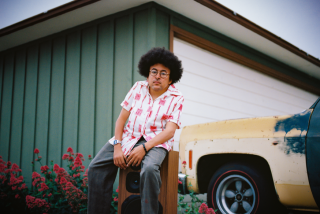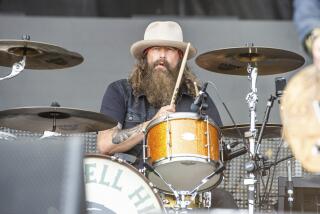PASSINGS: Doyle Bramhall, Winston C. Doby, Bruno Rubeo, Cargill MacMillan Jr.
Doyle Bramhall
Bluesman collaborated with Stevie Ray Vaughan
Doyle Bramhall, 62, a blues singer, drummer and songwriter best known for his collaborations with the late guitarist Stevie Ray Vaughan, died Saturday at his home in Alpine, Texas, the Houston Chronicle reported. The cause was not given.
Bramhall wrote or co-wrote numerous songs recorded by Vaughan, including “The House Is Rockin’,” “Life by the Drop,” “Scratch-N-Sniff” and “Tight Rope.”
In Texas he was a draw on his own, a bandleader with a gritty and soulful blues voice that greatly influenced the way Vaughan sang.
Bramhall was born Feb. 17, 1949, in Dallas. He said in interviews that his older brother was an early influence on his musical tastes.
“In the early ‘60s he had four or five friends who’d come over and listen to these great old blues albums,” Bramhall told the Houston Chronicle in 2007. “I’d sit outside his bedroom door and listen to Muddy [Waters] and B.B. [King] and Lightnin’ Slim and Lightnin’ Hopkins.”
In high school Bramhall started a band called the Chessmen featuring Jimmie Vaughan, Stevie Ray’s older brother, on guitar; the group once opened for Jimi Hendrix when he played Dallas.
By the 1970s Bramhall was keeping the beat in Texas Storm, which featured both Vaughan brothers and became popular on the club scene in Austin, Texas. Stevie Ray Vaughan died in a helicopter crash in 1990.
Bramhall later released a handful of solo albums. His son, Doyle II, plays guitar with Eric Clapton’s band.
Winston C. Doby
UCLA exec helped the educationally disadvantaged
Winston C. Doby, 71, a former UCLA vice chancellor for students who established groundbreaking programs to broaden opportunities for the educationally disadvantaged, died Thursday in Los Angeles after battling cancer, the university announced.
During more than three decades at UCLA, he became a “driving force” to improve educational opportunities for California students, the university said in a 2002 release.
Soon after joining UCLA’s administration in 1969, Doby established a nationally recognized program to provide support services for educationally disadvantaged students. He also launched a program in L.A. County schools that focuses on strengthening the skills of such college-bound students.
As vice chancellor from 1981 to 2001, he oversaw programs and services for about 35,000 UCLA students. He delayed retirement in 2001 to serve as vice president of educational outreach for the entire University of California system before retiring in 2006.
Winston Churchill Doby was born Feb. 20, 1940, in Alabama. The youngest of eight children, he moved to Los Angeles with his family when he was 5.
When his Fremont High School coach persuaded UCLA to give Doby a partial track scholarship, he extracted a promise from Doby to return to Fremont to teach.
After receiving a bachelor’s degree in mathematics, Doby taught at Fremont from 1963 to 1967 and later earned a master’s in administration and a doctorate in higher education from UCLA.
His several community-based education efforts included co-founding the L.A.-based Young Black Scholars Program, which helps prepare students for college; and Edutrain, a charter school for high school dropouts that closed in 1995.
Bruno Rubeo
Oscar-nominated art director
Bruno Rubeo, 65, a production designer who was nominated for an Academy Award in 1990 for the art direction on Bruce Beresford’s “Driving Miss Daisy,” died Nov. 3 of complications from pneumonia in Trevi, Italy, according to publicist Stan Rosenfield.
A native of Rome, Rubeo was hired by director Oliver Stone for the production design on “Salvador” (1986) and worked on three more films for the director: “Platoon” (1986), “Talk Radio” (1988) and “Born on the Fourth of July” (1989).
His other production designs include the 1989 Mexican period piece “Old Gringo,” the 1993 post-Civil War drama “Sommersby,” the 1994 film adaptation of John Grisham’s “The Client,” the 1999 remake of “The Thomas Crown Affair” and 2004’s “The Merchant of Venice,” set in 16th century Venice.
He also collaborated with director Taylor Hackford on five films, including Rubeo’s last, 2010’s “Love Ranch.”
“When movies have a big budget, it’s not just because of star salaries,” Rubeo told the Memphis Commercial Appeal in 1993 while working on “The Client,” which starred Susan Sarandon and Tommy Lee Jones. “A lot of money is also spent giving a movie a specific look. You shouldn’t be reminded of anything else.... You create a reality with your set.”
Rubeo’s wife, Mayes Rubeo, is a costume designer whose credits include “Avatar” and “Apocalypto,” and his son, Marco Rubeo, works as a set designer and art director.
Cargill MacMillan Jr.
Agribusiness heir, philanthropist
Cargill MacMillan Jr., 84, a billionaire heir to an agribusiness fortune and benefactor of the Palm Springs art scene, died Monday of natural causes at his Indian Wells home, said a spokesman for the Riverside County Sheriff’s Department.
MacMillan was worth an estimated $2.6 billion, according to Forbes magazine. He was an heir to Cargill, a Minnesota-based agricultural conglomerate that has $120 billion in revenue and is the largest private company in the world.
He served on the company’s board but had no day-to-day role in the business, which his great-grandfather founded in 1865 as a small grain storage company.
A native of Minnesota, MacMillan graduated from Yale University and moved to Indian Wells in 1990.
In 2009, Wells and his wife, Donna, donated a collection with a value of at least $20 million to the Palm Springs Art Museum.
-- Los Angeles Times staff and wire reports
More to Read
Start your day right
Sign up for Essential California for the L.A. Times biggest news, features and recommendations in your inbox six days a week.
You may occasionally receive promotional content from the Los Angeles Times.




















































